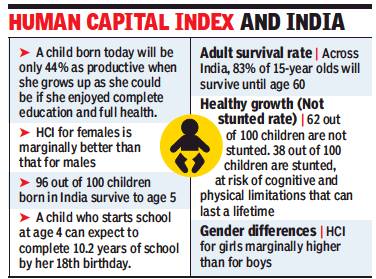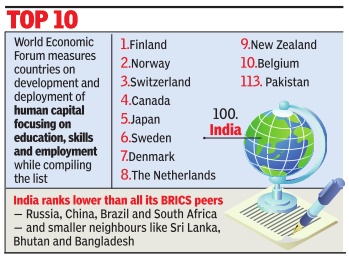Human Capital Index: South Asia
This is a collection of articles archived for the excellence of their content. |
Contents |
2015
The Times of India, May 15 2015
India ranks 100th on human capital index
India has been ranked at a lowly 100 position on the global Human Capital Index, which measures countries on development and deployment of human capital. Finland has topped the 124-nation list.
WEF said the list has been compiled on the basis of 46 in dicators about “how well countries are developing and deploying their human capital, focusing on education, skills and employment“.
On India, the report said that although the educational attainment has improved markedly over different age groups, its youth literacy rate is still only 90%, well behind the rates of other emerging economies. “India also ranks poorly on labour force participation rate due to its large informal sector,“ WEF added.
Among BRICS nations, Russia comes on the top at 26th position, followed by China (64), Brazil (78) and South Africa (92).
WEF said 14 countries have reached 80% human capital optimisation while 38 score 7080%. An additional 40 countries are somewhere between 60% and 70% while 23 countries score 50-60% and nine remain below the 50% mark.
In Asia and the Pacific the spread between the highest and lowest performing countries is among the widest.
After Japan, the best-performing countries are New Zealand (9), Australia (13) and Singapore (24) while Nepal (106), Myanmar (112) and Pakistan (113) occupy the lowest positions.
2016
The Times of India, Jun 29 2016
India was ranked low at 105th position globally on a worldwide Human Capital Index, which measures countries' ability to nurture, develop and deploy talent for economic growth.Finland topped the list. India ranks much below China's 71st position while Bangladesh, Bhutan and Sri Lanka are also placed higher on the index released by Geneva-based World Economic Forum (WEF) in the Chinese city of Tianjin at its Annual Meeting of New Champions -also known as `Summer Davos' summit.
Pakistan ranks further lower at 118th place. Giving India 105th rank out of the total 130 countries included in the index, WEF said the country has optimised just 57% of its human capital endowment -placing it in the top of the bottom quartile of the index.
India was ranked 100th in 2015 out of total 124 countries.
“Although the country's educational attainment has improved markedly over the different age groups, its youth literacy rate is still only 90% (103rd in the world),“ it added.
“India also ranks poorly on labour force participation, due in part to one of the world's largest employment gender gaps (121st).“
On positive side, India has got better rankings on quality of education system (39th), staff training (46th) and ease of finding skilled employees (45th) indicators. This suggests “a primary avenue for improvement for the country consists of expanding access to its numerous learning and employment opportunities“.
Thereport also showed that India had the largest share in the “global distribution of tertiary degree holders“ at nearly 78 million while it was second largest after China on global distribution of recent graduates in STEM subjects (science, technology , engineering and mathematics) at about 2.5 million. Finland, Norway and Switzerland hold the top three positions, utilising around 85% of their human capital.
Among BRICS countries, India is ranked lowest as against Russia's 28th, China's 71st, Brazil's 83rd and South Africa's 88th
2017
India at 103 rank on Global Human Capital Index; Norway on top, Sep 13, 2017: The Times of India

India has been placed at a low 103 rank, the lowest among BRICS economies, on the WEF's Global Human Capital Index, which has been topped by Norway.
India also ranks "among the lowest in the world" when it comes to the employment gender gap, but has fared well when it comes to development of skills needed for the future with a rank of 65 out of total 130 countries surveyed.
The list compiled by Geneva-based World Economic Forum (WEF) takes into account "the knowledge and skills people possess that enable them to create value in the global economic system" to measure the 'human capital' rank of a country.
India was ranked 105th on this list last year, while Finland was on the top which has pushed by Norway to second place this year. The WEF said India is ranked lower than its BRICS peers, with Russian Federation placed as high as 16th place, followed by China at 34th, Brazil at 77th and South Africa at 87th place. Among the South Asian countries also, India was ranked lower than Sri Lanka and Nepal, although higher than neighbouring Bangladesh and Pakistan.
"India is held back by a number of factors, including low educational attainment (primary education attainment among 25 -54 year olds is 110th for example) and low deployment of its human capital, meaning the skills available are not getting put to good use", WEF said. Giving examples, WEF said India ranks 118 for labour force participation among the key 35-54 year old demographic, suggesting far too many Indians are engaged in informal or subsistent employment.
"However there is a modern India rising. When it comes to development of skills needed for the future, the country fares strongly, ranking 65 out of 130," it said adding the country also performed well in the know-how parameter that measures the use of specialised skills at work. "India faces a number of challenges but looks to be moving in the right direction," WEF noted. The overall list was topped by Norway, followed by Finland and Switzerland in the second and third place respectively. Other countries in the top 10 include, the United States (4th), Denmark (5th), Germany (6th), New Zealand (7th), Sweden (8th), Slovenia (9th) and Austria (10th).
The report measures 130 countries against four key areas of human capital development; Capacity (determined by past investment in formal education), Deployment (accumulation of skills through work), Development (continued upskilling and reskilling of existing workers) and Know-how (specialised skills-use at work). According to the report, 62 per cent of human capital has now been developed globally. "The Fourth Industrial Revolution does not just disrupt employment, it creates a shortfall of newly required skills. Therefore, we are facing a global talent crisis," said Klaus Schwab, Founder and Executive Chairman, World Economic Forum.
Schwab further noted that "we need a new mind-set and a true revolution to adapt our educational systems to the education needed for the future work force".
2018
South Asia, China: the relative position
Bhutan and Maldives were not mentioned in the HCI table of the World Bank
Countries have been ranked according to the column "HUMAN CAPITAL INDEX "
Legend:
LI=Low income
LMI= Lower middle income
UMI=Upper middle income
Table begins
|
Country Name |
Probability of Survival to Age 5 |
Expected Years of School |
Harmonized Test Scores |
Learning-Adjusted Years of School |
Fraction of Kids Under 5 Not Stunted |
Adult Survival Rate |
HUMAN CAPITAL INDEX (LOWER BOUND) |
HUMAN CAPITAL INDEX |
HUMAN CAPITAL INDEX (UPPER BOUND) |
|
China UMI |
0.99 |
13.2 |
456 |
9.7 |
0.92 |
0.92 |
0.66 |
0.67 |
0.68 |
|
Sri Lanka LMI |
0.99 |
13.0 |
400 |
8.3 |
0.83 |
0.87 |
0.57 |
0.58 |
0.59 |
|
Nepal LI |
0.97 |
11.7 |
369 |
6.9 |
0.64 |
0.85 |
0.48 |
0.49 |
0.50 |
|
Bangladesh LMI |
0.97 |
11.0 |
368 |
6.5 |
0.64 |
0.87 |
0.47 |
0.48 |
0.49 |
|
Myanmar LMI |
0.95 |
9.9 |
425 |
6.7 |
0.71 |
0.81 |
0.46 |
0.47 |
0.49 |
|
India LMI |
0.96 |
10.2 |
355 |
5.8 |
0.62 |
0.83 |
0.43 |
0.44 |
0.45 |
|
Afghanistan LI |
0.93 |
8.6 |
355 |
4.9 |
0.59 |
0.78 |
0.38 |
0.39 |
0.40 |
|
Pakistan LMI |
0.93 |
8.8 |
339 |
4.8 |
0.55 |
0.84 |
0.37 |
0.39 |
0.40 |
Table ends
Govt ignores World Bank’s HCI
Govt to ignore World Bank’s HCI, October 12, 2018: The Times of India

From: Govt to ignore World Bank’s HCI, October 12, 2018: The Times of India
Centre Points To Data Gaps
The government has decided to ignore the World Bank’s human capital index (HCI) saying the score for India does not reflect the key initiatives that are being taken for developing human capital in the country.
The HCI, which was released on Thursday at the ongoing annual fund bank meeting in Bali, lists 157 countries and seeks to measure the amount of human capital that a child born today can expect to attain by the age 18 years.
The HCI has three components which include survival, as measured by under-5 mortality rates, expected years of quality-adjusted school and health environment using two proxies of adult survival rates and the rate of stunting for children under age 5.
“There are serious reservations about the advisability and utility of this exercise of constructing HCI. There are major methodological weaknesses, besides substantial data gaps,” a finance ministry statement said.
The government said for the schooling parameter, though quantity is assessed using enrolment rates reported by Unesco, quality is gauged using harmonised test scores from major international student achievement testing programmes.
“Due to lack of availability of an authoritative and uniform test score, about nine different test scores and systems using varying methodology have been claimed to have been harmonized by the World Bank. None of the nine systems cover more than 100 countries, with some having very limited regional coverage. This makes the methodology quite complex and nonuniform,” the statement said.
The government cited several programmes such as Samagra Shiksha Abhiyan, Ayushman Bharat , Swachh Bharat Mission, Pradhan Mantri Ujjwala Yojana, Pradhan Mantri Jandhan Yojana, which have been launched and are transforming human capital in the country at rapid pace and comprehensively touching upon the lives of millions of people living in rural and tribal areas.
